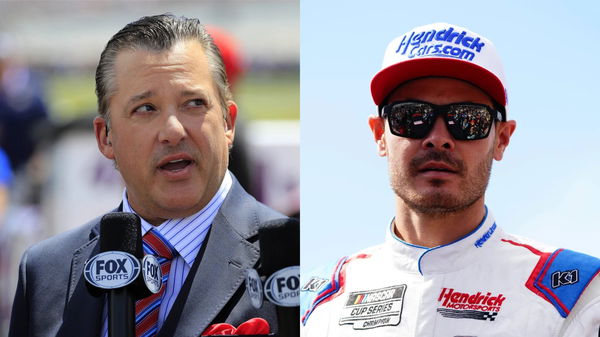
Imago
Kyle Larson, Tony Stewart

Imago
Kyle Larson, Tony Stewart
With the World of Outlaws already in the top sprint car circuits mix, starting the new dirt series, High Limit Sprint Car Series, was already a big step for Kyle Larson. Just a few years into the game, the Larson-Brad Sweet co-founded series is again breaking the headlines with its new franchise system. This update, set to begin from 2026, is interestingly controversial as it draws inspiration from NASCAR’s charter system. As polarizing as the news may be, given that NASCAR’s charter system is also in an ongoing anti-trust lawsuit with 23XI Racing and Front Row Motorsports, franchise owners are taking a shine to it.
Watch What’s Trending Now!
Before entering the new season, Tony Stewart’s new full-time racer and partner, Rico Abreu, shared his thoughts on the same. On Dale Earnhardt Jr.‘s podcast, Abreu explained, “The vision that Kyle Larson and Brad Sweet and Flo, you know, Mark Floreani, have created here is very appealing as a business owner, to be a part of something like that. Ultimately, that was one of my major decisions to compete with High Limit full-time.
“To be rewarded with a franchise, and possibly the number one franchise next year if we can win the championship, is going to be a huge step for me on the business side of operating my race team financially. I feel that it’s become very sustainable business. And another reason why I wanted to push towards this partnership with Tony (Stewart) and us collaborating on something really big here, Tony leasing the franchise from me. And High Limit approved the lease, so Tony Stewart Racing lease the franchise from Rico Racing.”
ADVERTISEMENT
From the business standpoint, the system certainly hits the mark. According to Larson, HLR will distribute its $18 million in total value in the next four years based on the teams’ performances. Here is a year-by-year breakdown:
- In 2026, the Franchise System is set to pay up to $3,970,000 to teams, including $2.6M guaranteed.
- In 2027, the Franchise System is set to pay up to $4,322,500 to teams.
- In 2028, the Franchise System is set to pay up to $4,620,000 to teams.
- In 2029, the Franchise System is set to pay up to $5,032,500 to teams, with up to $4.5M guaranteed to 15 potential franchisees by that year.
Already, Rico Abreu Racing (No. 24) is one of the top five franchises selected by HLR in 2024 for the Kubota High Limit Racing Franchise System. Apart from it, Kasey Kahne Racing (No. 49), Clauson-Marshall Racing (No. 7BC), Roth Motorsports (No. 83), and Murray-Marks Motorsports (No. 19) are also finalized. By the end of the 2025 season, five more teams will be added according to their average from the last two seasons. HLR also aims to add five new teams by the 2026-2027 season.
ADVERTISEMENT
Kyle Larson himself has championed the franchise as a way to build sustainability in dirt racing. In announcing the system, he stated, “We want to create something where teams can build equity and value in their organizations,” drawing direct parallels to NASCAR’s charters but aiming to avoid their pitfalls by tying value strictly to on-track results. For Abreu, this was a key factor in his switch to Tony Stewart Racing.
The new system also stabilizes the sport, and Abreu believes that joining HLR full-time with Tony Stewart Racing was the best way to ensure his Rico Racing grew. He clarified on the Dirty Mo Media podcast, “Over time, how you continue to perform… It’s gonna be performance-based, on where you’re seeded over a two-year period. So, I know how important it is to perform and continue to perform. And ultimately, it’s winning races. That’s performance, right?”
ADVERTISEMENT
Already, Abreu leads the High Limit Racing Championship with 10 wins this season. Joining hands with his friend and mentor, Stewart, will only mean that his full-time racer aspirations will come to fruition in a much more successful way. Since wins mean performance and performance means higher seeding, Abreu is not having wishful thinking when he says he wants to win the championship.
As for High Limit, it has seen rapid growth since its 2023 start, evolving from midweek events to a national tour with big purses, co-owned by FloSports. Yet, introducing franchises amid NASCAR’s lawsuit, filed in October 2024 over alleged anticompetitive practices, makes Larson’s step bold. The charter system introduced by NASCAR allows teams to act as franchises in other sports and guarantees their organizations a starting spot each week and prize money. While Larson’s franchise system also follows these, there’s one difference…
The charters are revocable by NASCAR and have expiration dates. On the other hand, the HLR franchise system promises long-term stability. It can potentially shift sprint racing dynamics toward more professionalized structures while risking divides between established and up-and-coming outfits. Only time will tell how this system works out.
ADVERTISEMENT
ADVERTISEMENT
ADVERTISEMENT
ADVERTISEMENT

